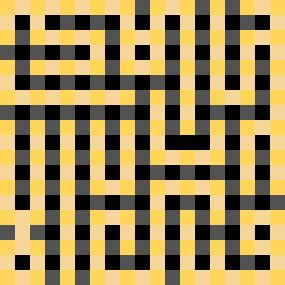Square Kufic (original) (raw)
Imagine having to write without vowels, wld y stll b bl t rd wht y wrt? This is what Hebrew and Arabic (and a few other scripts) do. You have to know the language already before you can read it. Reading in these languages is recognising the text, rather than reading it. In the old days, we’re talking 7th century here, the Arabic script was even more defective. Imagine the letters for b, t, th, n and y being exactly the same as well as the letters for s and z, v and w, b and p, g and k or ng. The starting sentence of this post would look something like this:
Mgb hvg b vrb vbb vvls, vld b sbll b bl b rd vhb b vrb?
Arabic had only 15 letters for 28 consonants. Only 6 letters were unequivocal, 7 had 2 potential values, 1 had 3 and 1 even had 5. It is in this script that the Qur’ an was first codified. No wonder Islam needed qurra’, people who knew the Qur’ an by heart. Transmission of Arabic texts was mainly oral. Written texts could only serve as some kind of reminder, not as a trustworthy codification of the exact text. This remained in the heads of reciters until the inevitable disagreements broke out.
About a century after the first codification of the Qur’an, so called ‘diacritical dots’ were added to solve the problem of different consonants hiding under the same letters. Those dots are now an integral part of the Arabic script. Another two centuries saw the completion of the system for noting the vowels: small strokes above and under the letters that not only indicated vowels, but also the doubling of a consonant or the absence of a vowel. One of these small signs -the _hamza_– made it back into the Arabic alphabet as a separate letter. These signs are still used, but only in the Qur’an, in poetry and in spelling foreign words.
Arabic -in short- is a defective writing system with two repair-patches. As a script, it should have been discarded as quickly as possible for a better one. But it wasn’t and for a good reason: it’s perfect for calligraphy. No other script has developed so many rules and styles of writing that are still in use today. One of those styles is based on the original Arabic script without vowels and diacritical dots. It dates from the early Middle Ages but looks like modern design. In fact: most laypeople do not even recognise it as text. It is called ‘Square Kufic’.
Designs like these can be easily executed in tiles or pixels, so they look like ‘designs’ instead of texts. Deciphering them can be extremely difficult, except in the case of short, standard texts like ‘Allah’ or ‘Muhammad’. The rules of Square Kufic are so strict I’ve often wondered why you never see a computer program that you can enter text into and that will help you fit it into a square or rectangle. If you treat Square Kufic designs as rows and columns of pixels, they are always made up of an uneven number of rows and columns.
As you can see in the above picture, the pixels with uneven coordinates are always part of the text (the orange pixels), while those with even coordinates are not (the black pixels). There are few exceptions to the latter rule (there is one in the lower left corner). Pixels with even/uneven coordinates are either part of the text (the yellow pixels) or not part of the text (the dark grey pixels). No four adjacent pixels arranged in a square are ever all four of the same colour, and no two pixels diagonally adjacent are ever the same colour without a third one. It should be possible to automate this.
This is the most simple-looking -but most difficult in its execution- method of making Square Kufic. It’s easier to arrange Square Kufic text around the edges of a square and fill in the empty middle with the ‘lattice-work’ like in the first example. Trying to fit a particular string into a square is perfect for killing time. I have a Moleskine squared notebook to use in the train back and forth to work.
For those who’ve tried to decipher the two designs:
- The top one reads: ام النور ‘Mother of Light’. It is repeated four times and starts approximately in the middle of the four sides of the square.
- The bottom one reads: فباي الا ربكما تكذبان ‘which is it, of the favours of your Lord, that ye deny?’ the refrain of Surat al-Rahman, the 55th chapter of the Qur’ an. It starts at the bottom right corner and spirals inward: the end of the sentence is roughly in the middle of the square.
This entry was posted on February 12, 2008 at 4:32 pm and is filed under Arabic with tags Arabic, calligraphy, design, islam, Qur'an. You can follow any responses to this entry through the RSS 2.0 feed. You can leave a response, or trackback from your own site.

